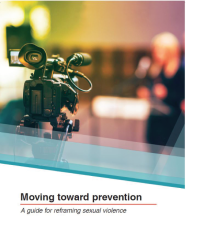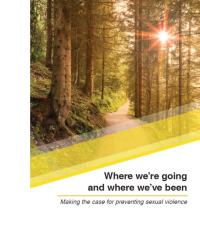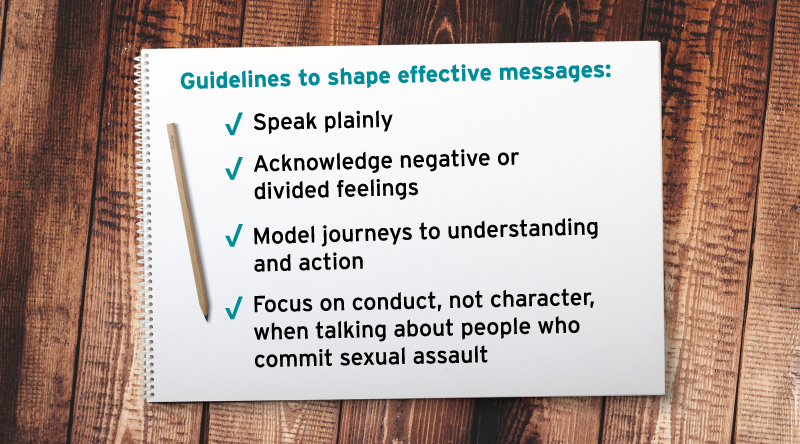
Getting on message: New resources to help advocates communicate about prevention
By Pamela Mejia and Daphne Marvel
Berkeley Media Studies Group
Sexual violence is upsetting to think about, so people often try to avoid talking about it. That means that one key fact often gets lost: sexual harassment, abuse, and assault don’t have to be just a fact of life.
What will it take to help advocates, practitioners, and anyone who wants to play a role in prevention illustrate that prevention is possible, that it’s happening, and that everyone can take concrete steps to be part of it?
Five years ago, Berkeley Media Studies Group set out to answer that question with support from the National Sexual Violence Resource Center and partners across the sexual violence prevention field. In 2018, we published a set of tools and resources to help anyone committed to prevention use strategic communication to make the case for prevention strategies and approaches – whoever and wherever they are. The tools provide step-by-step guidance for constructing effective messages, reframing sexual violence to include prevention, and engaging journalists to make prevention part of news about sexual violence.
In brief, we found that an effective message about prevention should include:
1) A statement of shared values (such as innovation, caring for the next generation, or safety): Leading with shared values gives people an entry point into a difficult conversation they may not otherwise feel ready to have.
2) Acknowledgment of negative feelings, like discomfort, fear, or lingering doubts: Once we address the initial discomfort that people feel around the topic of sexual violence, we are better able to model a path forward and shift the conversation toward tangible action and change.
3) Description of a journey toward change: We can show people that prevention is possible when we show them the journeys that others have taken from doubt, fear, inaction, or ignorance toward knowledge, bravery, and commitment to preventing abuse and assault.
4) Precise statement of the problem: It can be tempting to try and say everything that you know about sexual violence prevention any time you talk about it, but it’s impossible to be comprehensive and strategic at the same time. To make your statement of the problem clear and understandable, focus on just one aspect at a time, based on your overall strategy.
5) Examples of success: People need to see that prevention is working – and success measures don’t have to be dramatic! No amount of progress is too small – every step toward prevention is a step in the right direction.
6) A concrete solution: Audiences don’t have many examples of prevention in action, and they are hungry to learn more about what it looks like. We found that by naming the immediate approach you are pursuing to stop sexual violence before it happens, you can help people see that prevention is possible.
Of course, after five years of intensive research, this list represents just the tip of the iceberg. With material so complex and multi-faceted, we’ve found that anyone who wants to use it needs interactive, immersive opportunities to put it into practice and think through how to adapt it for their own work. We’re in the midst of developing and delivering interactive trainings on framing and message development to prevention coalitions around the country. Based on the positive responses we’ve received, we’re looking forward to more opportunities to help advocates and practitioners develop the skills and confidence they need to match their passion for making everyone safer by preventing sexual violence before it happens.
Stopping sexual harassment, abuse, and assault before they happen can feel overwhelming, but our work together on this project over the last six years has made us more confident than ever that we can help people effectively make the case for preventing sexual harassment, abuse, and assault across the lifespan – whoever and wherever they are.
For more information on building your overall strategy, framing sexual violence prevention, constructing messages, and engaging reporters to talk about prevention, please visit bmsg.org to review Where We’re Going and Where We’ve Been, Moving Toward Prevention: A Guide for Reframing Sexual Violence, and the media relations toolkit.
Want to put the research into practice in your own community? Please contact Pamela Mejia at mejia@bmsg.org, or NSVRC at resources@nsvrc.org.
Find the guides at:
bit.ly/WhereWereGoingWhereWeveBeen
bit.ly/TowardPrevention
bit.ly/MediaRelationsToolkit
Find BMSG at:
www.bmsg.org
www.twitter.com/bmsg
www.facebook.com/BerkeleyMediaStudiesGroup
This article appears in the Spring 2019 print edition of The Resource.



